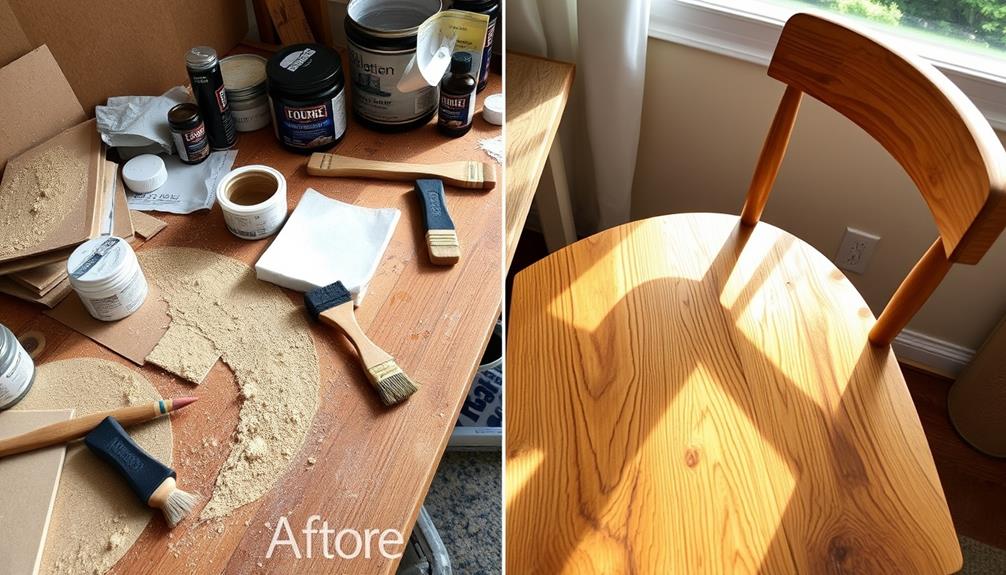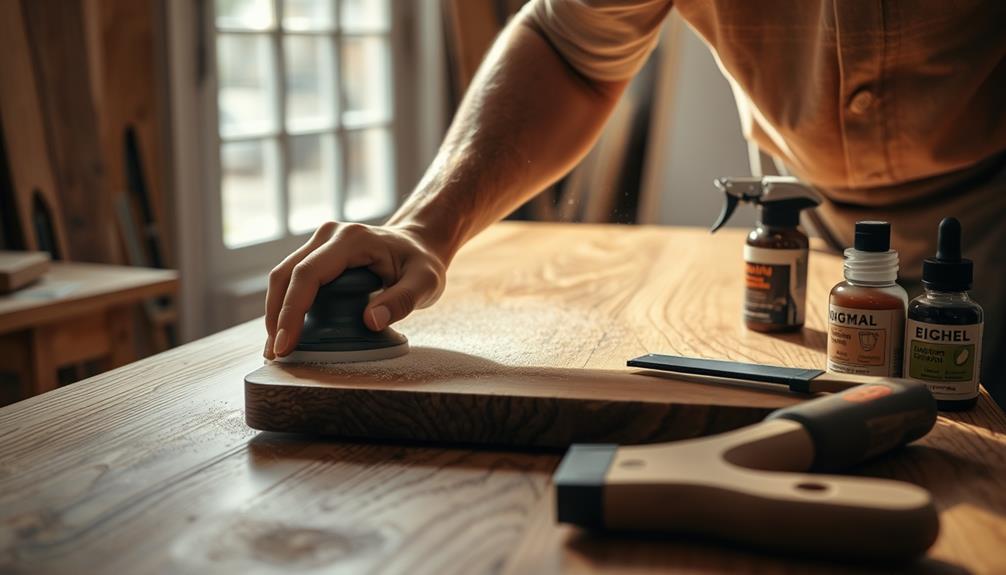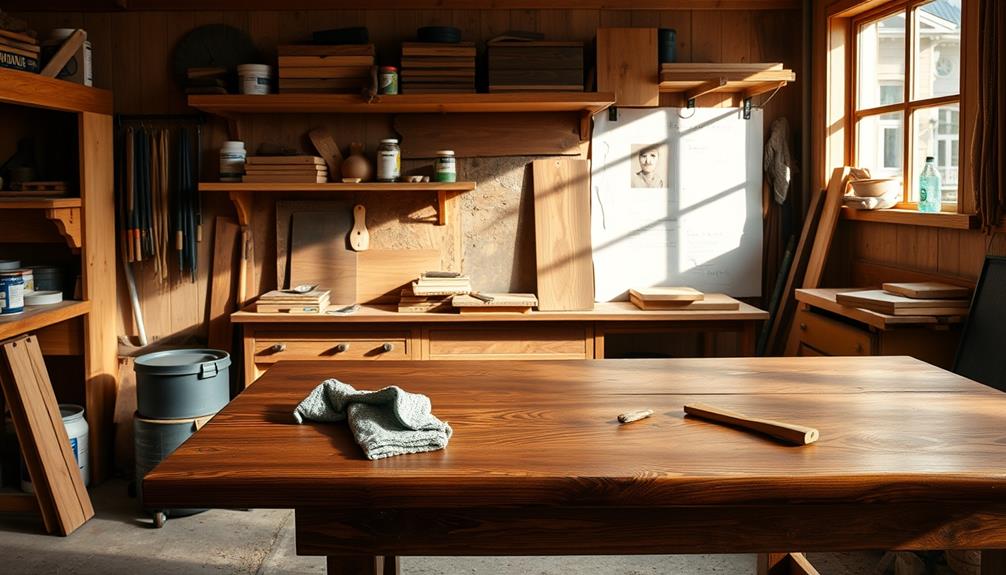To refinish wood furniture, start by assessing its condition for any scratches and structural issues. Use a chemical stripper and scraper to remove old finishes. After stripping, sand the surface with various grits of sandpaper, starting with a coarse grit and progressing to finer ones for a smooth finish. Apply your chosen stain, wiping off any excess. Finish with a durable clear coat, sanding between layers for the best results. Refinishing requires time and attention to detail, but the outcome is rewarding, especially when it showcases your personal touch and story. Find more tips to enhance your project here. To preserve the newly refinished wood furniture, use coasters and placemats to shield the surface from water rings and scratches. Regular dusting and cleaning with a mild wood cleaner will help maintain the finish. Periodically check for any signs of wear and tear, addressing them promptly to prevent further damage. For additional wood furniture maintenance tips, refer to professional guides or resources to ensure your furniture retains its best appearance for years to come.
Key Takeaways
- Assess the furniture's condition to determine if it needs refinishing, restoring, or refurbishing before starting the project.
- Use a chemical stripper to remove old finishes, applying it evenly and scraping off softened layers while ensuring safety precautions.
- Sand the wood with progressively finer grits of sandpaper for a smooth surface, then use a tack cloth to remove dust before staining.
- Choose the right stain and finish, considering durability, aesthetic preferences, and testing a small area for compatibility.
- Be patient and attentive to detail throughout the process, ensuring each step contributes to a polished and long-lasting result.
A Bit of Backstory
Refinishing wood furniture isn't just about aesthetics; it's a journey through personal and historical narratives. When you pick up an old piece from a thrift store, you're not just acquiring furniture; you're inviting a story into your home. Each scratch and dent is a chapter, and as you start refinishing furniture, you breathe new life into that history.
The beauty of wood becomes your canvas, and with every stroke, you connect with the past. This process can also enhance your problem-solving abilities, as you learn to navigate unexpected challenges that arise during refinishing, ultimately promoting a curiosity for continuous learning.
As you sand, stain, and polish, you're not just transforming an outdated piece; you're crafting a legacy. This practice empowers you to turn forgotten relics into cherished artifacts that reflect your personal stories. Perhaps that dining table was once a gathering spot for family celebrations or that dresser held secrets of a bygone era.
Your refinishing journey can inspire others too. By sharing your projects, you foster community engagement and connect with fellow enthusiasts who appreciate the emotional investment behind each piece.
Vintage hunting journals and social media become invaluable resources, offering inspiration and creativity. So, immerse yourself in this rewarding process, and let your refinished furniture tell its story alongside yours.
Importance of Preservation

Preserving the stories embedded in wood furniture is essential for maintaining our cultural heritage and personal connections. When you refinish a piece, you're not just enhancing its look; you're honoring the craftsmanship and history that shaped it.
This thoughtful transformation strengthens emotional connections, especially with family heirlooms that carry cherished memories. Each refinished item becomes a vessel for these narratives, ensuring they're passed down through generations.
Additionally, refinishing promotes sustainability. Instead of discarding old furniture, you're extending its lifespan and reducing waste. This approach not only benefits the environment but also enriches your understanding of the craftsmanship involved in creating such pieces, reminiscent of the modern farmhouse decor trends that emphasize the beauty of natural materials.
As you engage in these projects, you cultivate a deeper appreciation for both the artistry and the stories behind each item.
Ultimately, every effort you make to preserve wood furniture contributes to a broader cultural heritage, fostering a sense of belonging within your community. By investing time and care into these pieces, you're actively participating in the preservation of history, creating a legacy that celebrates both personal and collective identities.
Embrace the importance of preservation, and let your refinishing journey begin.
Refinishing Terminology Explained

When diving into the world of furniture restoration, understanding key terminology is essential for successful projects.
First, let's talk about refinishing. This process involves removing the old finish and applying a new one, enhancing the furniture's appearance while preserving its original structure. Knowing how to refinish wood furniture can greatly improve its look and feel. Regular maintenance, such as cleaners link for wood surfaces, can also prolong the life of your refinished pieces.
Next, there's restore. This term refers to bringing a piece back to its original state with minimal repairs. The focus here is on preserving its historical integrity, making it ideal for antique pieces.
On the other hand, refurbish involves making significant repairs or even structural changes. This might include replacing parts or altering the design to improve functionality.
Before you start any project, it's vital to assess the condition of your furniture. This initial evaluation helps you decide whether to refinish, restore, or refurbish based on the extent of damage and your desired outcome.
Familiarity with these terms won't only guide your refinishing process but also enhance your communication with fellow woodworking enthusiasts.
Tools and Workspace Setup

To get started on your refinishing project, you'll need the right tools and a well-organized workspace.
Gather essential items like sandpaper, a random orbital sander, and safety gear to protect yourself.
A tidy area will help you focus on the task at hand and keep everything you need within easy reach.
Essential Tools Needed
Refinishing wood furniture requires a blend of preparation and the right tools to achieve a stunning result. Start by gathering essential items like sandpaper in various grits. You'll need finer grits for smoothing and coarser ones for initial sanding. An orbital sander is invaluable for tackling larger pieces quickly and evenly.
Don't forget a scraper to help remove old finishes effectively. Safety is key, so equip yourself with goggles and a dust mask to protect against harmful dust and fumes. Working in a well-ventilated area is vital to guarantee you're not breathing in any toxic particles, especially when using paint stripper.
You'll also want cleaning products like tack cloths and mineral spirits handy for surface preparation and cleanup after stripping and sanding. These will help you achieve a clean surface for refinishing.
Organizing Your Workspace
Creating a well-organized workspace is essential for a smooth refinishing experience. Start by designating a specific area that offers ample room to move around and work comfortably.
Confirm your workspace is well-ventilated; this minimizes exposure to harmful fumes from chemicals and finishes. You can use fans or exhaust systems to help with airflow.
To keep everything in order, follow these key steps:
- Store Tools: Use toolboxes or pegboards to keep essential tools like sandpaper and brushes easily accessible. This reduces clutter and enhances efficiency.
- Label Hardware: Utilize storage containers or jars to organize and label small hardware components. This way, you won't lose any pieces during disassembly and refinishing.
- Protect Surfaces: Line your work area with drop cloths to protect the floor from spills, stains, and debris generated during the refinishing process.
Safety Gear Importance
Wearing the right safety gear is essential when refinishing wood furniture, as it protects you from harmful dust and fumes. Start with a good pair of goggles to shield your eyes from particles and splashes. A dust mask is also imperative, as it filters out harmful dust and fumes generated during the refinishing process. This gear greatly reduces your risk of respiratory issues and eye injuries.
Next, verify your workspace has adequate ventilation. Open windows or use fans to help dissipate harmful fumes from chemical strippers and paints. This step is critical for maintaining a healthy environment while you work.
To keep your workspace safe and efficient, organize it well. A clutter-free area allows for easy access to your essential tools, reducing the likelihood of accidents.
Use drop cloths or plastic sheeting to protect surfaces from spills and stains, keeping the area clean.
Step-by-Step Refinishing Process

To start the refinishing process, you'll want to assess the condition of your furniture piece to identify any necessary repairs.
Once you've addressed those issues, stripping old finishes and sanding the surface will prepare it for a fresh look.
Assess Furniture Condition
Starting with a thorough inspection is essential for evaluating the condition of your furniture before refinishing.
You'll want to assess every part carefully for any damage, which could affect your refinishing plans. Here's what to look for:
- Surface Damage: Check for scratches, dents, and any visible wear. These imperfections might require sanding or filling for a smooth finish.
- Structural Integrity: Examine joints and connections for any signs of weakness or rot. If you find any, you may need to repair or reinforce these areas before proceeding.
- Hardware and Components: Confirm all essential hardware, like knobs or screws, are intact. Missing parts can complicate the assembly after refinishing.
Document your findings with photos and notes.
This won't only help you keep track of the furniture's condition but also guide your repair efforts.
Stripping Old Finishes
Stripping old finishes from wood furniture is an essential step in the refinishing process. Start by applying a chemical stripper, like CitriStrip, evenly over the wood surfaces using a brush. Allow it to sit for 5-10 minutes so it can soften the old finish.
Once that's done, use a scraper tool to gently remove the softened finish. Wipe the blade frequently to avoid buildup and guarantee effective removal.
If you encounter stubborn finishes, don't hesitate to apply the stripper multiple times, allowing sufficient drying time between applications. After you've successfully stripped old finishes, clean the surface with mineral spirits to remove any residue from the stripper. This step is key, as it verifies the wood is completely dry and ready for the next phase of your project.
Always follow safety precautions during this process. Wear gloves and goggles, and work in a well-ventilated area to minimize exposure to harmful chemicals.
Sanding and Staining
Sanding and staining are essential steps in the refinishing process that breathe new life into your wood furniture.
Start by using a coarse grit sandpaper (around 80-120 grit) with a sanding block to remove the old finish and smooth out rough areas. Progress to finer grits (180-220 grit) for a polished surface. Always sand along the grain to prevent scratches and achieve that smooth finish.
After sanding, wipe down the piece with a tack cloth to remove all dust before you apply the stain.
Here's a quick guide to staining your wood:
- Choose Your Stain: Select a stain that complements the wood type. Oil-based stains offer richer colors, while water-based stains dry quicker and are easier to clean up.
- Apply the Stain: Use a staining pad or brush to apply the stain in long, even strokes. Let it penetrate for a few minutes and then wipe off the excess to reach your desired color intensity.
- Finish Up: After the stain is fully dry, apply a protective clear coat, like oil-based polyurethane, sanding lightly between coats for a smooth finish.
Quality and Patience in Refinishing

When you immerse yourself in the world of refinishing wood furniture, quality and patience play an essential role in achieving stunning results. Rushing through the process can diminish the overall value and aesthetic appeal of your piece.
Each step, from sanding to applying the final coat, requires your full attention to guarantee a smooth and durable finish that enhances the wood's natural beauty.
Initial projects often serve as practice, allowing you to develop your skills and appreciate the time invested in quality craftsmanship.
Understanding that each refinished piece requires careful attention to detail is vital. For instance, sanding between coats can greatly improve the final outcome, leading to a polished look that reflects your commitment to excellence.
Selecting the Right Finish

Choosing the right finish is essential for bringing out the beauty of your refinished wood furniture while guaranteeing it withstands daily use.
When selecting the right finish, consider the following factors to achieve the best results:
- Durability: If your furniture gets heavy use, opt for durable finishes like polyurethanes or lacquers. These can withstand scratches and wear better than oil finishes.
- Imperfections: Assess the condition of your wood. If there are visible flaws, less transparent finishes can help conceal imperfections, while clear finishes will highlight the natural grain.
- Personal Preference: Your aesthetic choice matters. Decide whether you prefer a glossy or matte appearance, and consider color options, such as dark versus light finishes.
Before committing to a finish, it's wise to test a small area to guarantee compatibility with the wood surface and achieve your desired look.
Frequently Asked Questions
How to Refinish Wood Furniture for Beginners?
To start, clean the surface thoroughly, then sand it down. Decide between painting or staining based on your style. Finally, apply a protective finish to guarantee durability and maintain your furniture's beautiful appearance.
Is It Better to Sand or Strip Wood Furniture?
It's a common belief that stripping's always better, but it depends on your project's needs. If the finish is thick, stripping works best; for minor touch-ups, sanding might be your go-to method.
Can You Refinish Furniture Without Stripping?
Yes, you can refinish furniture without stripping. Just clean the surface, lightly sand with 220-grit sandpaper, apply a compatible stain, and finish with a protective coat. It's a simpler process that still yields great results!
How to Strip and Stain Wood Furniture?
To strip and stain wood furniture, apply a chemical stripper, gently scrape off the old finish, clean with mineral spirits, sand the surface, then apply your stain evenly, removing excess for a perfect finish. After the stain has dried, it’s important to seal the wood with a protective finish to ensure durability. If your furniture has previously been treated with wax, take the time to remove wax from wooden furniture before applying any stains or coatings, as this can interfere with adhesion. Finally, allow the final finish to cure completely before using the furniture to achieve the best results.
Conclusion
In the end, refinishing wood furniture isn't just about restoring its beauty; it's about preserving a piece of history. By investing your time and effort, you're not only giving new life to an old piece but also creating a unique story that's just waiting to be shared. Remember, good things come to those who wait—so take your time, enjoy the process, and watch as your furniture transforms into a cherished masterpiece.









